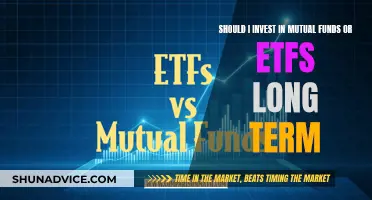
Mutual funds are a great way to build a diversified portfolio without a lot of extra cost or hassle. They are a type of investment vehicle that pools money from multiple investors to purchase a diversified portfolio of stocks, bonds, or other securities. This allows individual investors to gain exposure to a professionally managed portfolio and potentially benefit from economies of scale, while also spreading risk across multiple investments.
1. Define your investment goals and risk tolerance: Are you investing for the short-term or long-term? Do you want to focus on capital preservation or growth? Different mutual funds cater to different investment objectives and risk profiles, so it's important to understand your own goals before investing.
2. Choose the right mutual fund strategy: Based on your goals and risk tolerance, you can select the appropriate mutual fund strategy. For example, if you are investing for the long-term, you may want to allocate a larger portion of your portfolio to stock-based mutual funds. On the other hand, if you are approaching retirement, you may want to consider a more conservative approach with a greater allocation to bond funds.
3. Research potential mutual funds: Look at the past performance, expense ratios, load fees, and management style of different mutual funds to identify those that align with your investment goals and risk tolerance. Compare funds within similar categories and consider their long-term track record, not just recent performance.
4. Open an investment account: You can invest in mutual funds through an employer-sponsored retirement plan, such as a 401(k) or 403(b). Alternatively, you can open a brokerage account on your own, such as an individual retirement account (IRA) or a taxable brokerage account.
5. Purchase shares of mutual funds: Ensure you have enough money deposited in your investment account to meet the minimum investment requirements of the mutual funds you have selected. Keep in mind that mutual funds usually have higher investment minimums than other asset classes.
6. Set up a regular investment plan: Consistency is key when it comes to investing. Consider setting up recurring investments on a regular basis to grow your wealth over time. This can also help you benefit from dollar-cost averaging, which smooths out the price you pay per share over time.
7. Monitor and rebalance your portfolio: It's important to periodically check on the performance of your mutual funds and make adjustments as needed. Additionally, consider meeting with a financial advisor at least once a year to review your investment strategy and ensure it remains aligned with your goals.
| Characteristics | Values |
|---|---|
| Investment type | Pooled investment vehicle |
| Investment vehicle | Mutual funds |
| Investment objective | Diversified portfolio of stocks, bonds or other securities |
| Management | Professionally managed |
| Access | Accessible way for investors to get access to a wide mix of assets |
| Risk | Spread risk across multiple investments |
| Returns | Returns based on fund's performance minus any fees or expenses charged |
| Fees | Annual fees, expense ratios, or commissions |
| Investment options | Stock, money market, bond, and target-date funds |
| Buying process | Decide on investment goals, pick a strategy, research potential funds, open an investment account, purchase shares, set up a plan to invest regularly, consider exit strategy |
| Selling process | Place a sell order on the platform |
What You'll Learn

Understand the different types of mutual funds
Understanding the different types of mutual funds is a crucial step in deciding how to invest in them. Here is an overview of the various types of mutual funds to help you make informed decisions:
Money Market Funds
Money market funds are considered a relatively low-risk investment option. By law, they can only invest in specific high-quality, short-term instruments issued by US corporations and federal, state, and local governments. These funds offer a safe and secure investment opportunity, making them attractive to investors seeking stability.
Bond Funds
Bond funds aim for higher returns compared to money market funds and thus carry higher risks. The variety of bonds available in the market, such as government bonds, corporate bonds, and other debt instruments, means that bond funds can vary significantly in their risk profiles and potential returns.
Stock Funds
Stock funds, as the name suggests, invest in corporate stocks. These funds can be further categorized based on the size of the companies they invest in, their investment approach, and whether they focus on US stocks or foreign equities. Examples include growth funds, income funds, index funds, and sector funds.
- Growth funds focus on stocks with potential for above-average financial gains, even if they may not pay regular dividends.
- Income funds, on the other hand, invest in stocks that provide regular dividend payments.
- Index funds track a specific market index, such as the Standard & Poor's 500 Index.
- Sector funds specialize in a particular industry segment, like healthcare or technology.
Target Date Funds
Target date funds, also known as lifecycle funds, hold a mix of stocks, bonds, and other investments. Over time, the mix of these assets gradually shifts according to the fund's strategy. These funds are designed for individuals with specific retirement dates in mind, adjusting their risk profile as the target date approaches.
International and Regional Mutual Funds
International mutual funds invest only in assets outside of the investor's home country, while global funds can invest anywhere worldwide. Regional mutual funds, on the other hand, focus on specific geographic regions, such as a country, continent, or group of countries with similar economic characteristics. These funds provide investors with the opportunity to capitalize on the growth potential of specific regions while diversifying their portfolios internationally.
Sector and Theme Mutual Funds
Sector mutual funds aim to benefit from the performance of specific sectors of the economy, such as finance, technology, or healthcare. Theme funds, on the other hand, can cut across multiple sectors. For example, a fund focused on artificial intelligence (AI) may invest in a variety of industries beyond the tech sector, such as healthcare and defense.
Socially Responsible Mutual Funds
Socially responsible investing (SRI) or ethical funds invest only in companies and sectors that meet certain preset criteria. For instance, some SRI funds avoid industries like tobacco, alcoholic beverages, weapons, or nuclear power. Sustainable mutual funds, in particular, focus on green technology and renewable energy sources.
Additionally, some funds consider environmental, social, and governance (ESG) factors when selecting investments. These funds prioritize companies with management practices that positively impact the environment and community.
Investing Now: Choosing the Right Funds for Your Portfolio
You may want to see also

Know the pros and cons
Mutual funds are a great way to build a diversified portfolio without a lot of extra cost or hassle. They are also an excellent option for people who don't have the time, education, money, or willingness to manage a large portfolio of investments. However, there are some pros and cons to investing in mutual funds that you should be aware of.
Pros
- Diversification: Mutual funds allow you to invest in a range of securities rather than just one or two, reducing the risk of any one company causing your investment to lose value.
- Professional management: The fund manager does all the research and monitors the performance of the securities for you.
- Low costs: Mutual funds are relatively affordable and let you purchase hundreds of securities for a low cost.
- Ease of access: Mutual funds are traded on major stock exchanges, making them highly liquid investments that can be bought and sold with relative ease.
- Economies of scale: Mutual funds enable investors to take advantage of dollar-cost averaging and lower transaction costs.
Cons
- High fees: Mutual funds charge annual fees, expense ratios, or commissions, which can lower overall returns.
- Lack of transparency: It can be difficult to compare funds due to a lack of transparency in holdings.
- End-of-day trading only: Mutual funds can only be bought or sold at the end of the trading day, unlike stocks and ETFs that can be traded throughout the day.
- Tax implications: When the fund manager sells a security, a capital-gains tax is triggered, which can be extended to the investor.
- Potential for depreciation: There is always the possibility that the value of your mutual fund will depreciate.
TSP L Funds: Choosing the Right Investment for You
You may want to see also

Learn how to choose a mutual fund
When choosing a mutual fund, it's important to consider your financial goals, risk tolerance, and the types of investments that align with your plan. Here are some key factors to keep in mind when selecting a mutual fund:
- Investment Objectives: Ensure that the fund's investment objectives match your long-term financial plan. For beginners, investing in a low-cost S&P 500 index fund is often a good option. For more experienced investors or those seeking actively managed funds, further research is needed.
- Investment Approach and Philosophy: Understand the fund's overall approach, investing strategy, and the portfolio managers who will be making investment decisions. Look into their track record and whether their approach aligns with your goals.
- Performance: While past performance doesn't guarantee future results, it's important to consider a fund's historical returns over different time periods. Compare these returns with similar mutual funds or benchmark indices to assess how well the fund is meeting its stated goals.
- Fees and Expenses: Mutual funds typically charge various fees, including management fees, expense ratios, sales commissions (loads), and other operating expenses. Evaluate the fees associated with the fund and compare them with similar funds. Remember, higher fees can significantly impact your investment returns over time.
- Risk Profile: Different mutual funds carry different levels of risk. Consider your risk tolerance and choose funds that match your comfort level. For example, funds with a higher allocation of stocks tend to be riskier but offer higher potential returns, while bond funds are generally less risky but provide lower returns.
- Investment Holdings: Look into the specific investments that the mutual fund holds. Ensure that you understand the underlying assets and their potential risks. Diversification across various assets, industries, or sectors can help mitigate risk.
- Fund Size and Reputation: Consider the size and reputation of the fund provider. Larger, well-known fund companies like Vanguard or Fidelity may offer a wider range of funds and have a stronger track record. However, smaller fund providers may provide more specialized or niche investment options.
- Tax Implications: Be mindful of the tax consequences associated with investing in mutual funds. Capital gains taxes may apply when you sell fund shares, and some funds distribute capital gains to investors even before they sell their shares. Additionally, dividends received from mutual funds are usually taxable.
- Minimum Investment: Mutual funds typically have minimum investment requirements, which can range from a few hundred to a few thousand dollars. Ensure that you meet the minimum investment amount before selecting a fund.
- Fund Comparison: Compare multiple mutual funds across different providers to find the best fit for your needs. Consider using fund screeners and research tools offered by investment companies to narrow down your options.
Vanguard Index Fund: Minimum Investment Requirements and Opportunities
You may want to see also

Know how to buy and sell mutual funds
Mutual funds can be purchased through online brokers or through the fund manager themselves. But there are some differences between the way mutual funds trade and the way a stock or ETF trades.
Pricing
Mutual funds are priced at the end of each trading day based on their net asset value, or NAV. The NAV is calculated by adding up the value of the fund’s holdings, subtracting expenses and dividing by the number of shares outstanding. When making a purchase, you’ll receive the next NAV, so if you place an order after the market has closed, you will receive the next day’s closing NAV as your price.
Minimum investment
Most mutual funds have a minimum investment of a few thousand dollars and you can choose to buy a certain dollar amount of a fund or a specific number of shares.
How to sell mutual funds
Mutual funds are sold similarly to the way they’re bought. Using an online broker or the fund’s manager, you’ll place a sell order and will receive the next available NAV as your price. Since mutual funds don’t trade throughout the day like stocks or ETFs, you won’t know the price you’re selling at until the trade goes through.
Mutual funds sometimes have fees for selling the fund in a short period of time, known as early redemption fees, and are therefore not ideal for short-term trading. They’re best used as vehicles for long-term investment and are commonly held in retirement accounts or invested towards another long-term goal. You don’t need to monitor the fund’s performance daily or even weekly when you’re invested for the long run. Checking in quarterly or a couple of times each year should be enough to make sure the fund is still aligned with your objectives.
Covered Funds: A Smart Investment Strategy?
You may want to see also

Understand how mutual funds are taxed
Understanding how mutual funds are taxed is an important part of investing in them. Mutual funds are taxed based on the type of distribution received, the duration of the investment holding, and the type of investment. Most distributions you receive from a mutual fund must be declared as investment income on your yearly taxes. However, distributions can be taxed at either your ordinary income tax rate or the capital gains tax rate, depending on the specifics of the distribution and the underlying investments within the fund's portfolio.
If you receive a distribution from a fund that results from the sale of a security the fund held for only six months, that distribution is taxed at your ordinary income tax rate. If the fund held the security for several years, however, then those funds are subject to the capital gains tax instead. In general, only investment income you derive from investments held for more than a year is considered capital gains.
Mutual funds also make dividend distributions when underlying assets pay earnings or interest. Mutual funds are pass-through investments, meaning any income they receive must be distributed to shareholders. This most often occurs when a fund holds dividend-bearing stocks or bonds, which pay a regular amount of interest annually, called a coupon. In general, dividend income is taxed as ordinary income. However, there are two important exceptions: qualified dividends and tax-free interest.
Dividend distributions received from your mutual fund may be subject to the capital gains tax if they are considered qualified dividends by the IRS. For a dividend to be qualified, it must be paid by a stock issued by a US or qualified foreign corporation, and your mutual fund must have held the stock for more than 60 days within the 121-day period beginning 60 days before the ex-dividend date. The ex-dividend date is the date after which the owners of newly purchased stock are ineligible for the dividend payment.
The other way to minimize your income tax bill is to invest in so-called tax-free mutual funds. These funds invest in government and municipal bonds that pay tax-free interest. Money market mutual funds, for example, invest primarily in short-term government bonds and are widely considered stable and safe investments. However, while municipal bonds pay interest that is exempt from federal income tax, they may not be exempt from your state income tax or local income taxes. In some cases, interest paid on bonds issued by governments in your state of residence may be triple-tax-free, meaning the bonds are exempt from all income tax.
Calculating the taxes you owe on mutual fund income and distributions can be complex, and unless you own just a handful of shares and keep careful records, you may benefit from consulting a tax professional to ensure you are properly reporting all your investment income.
Index Funds: A Smart Investment Strategy for Long-Term Wealth
You may want to see also
Frequently asked questions
Mutual funds are a type of investment that allows a group of investors to pool their money together to invest in something. They are managed by a team of investment professionals who select a mix of investments to include in the fund based on its objective.
Mutual funds are a good investment option because they are simple, affordable and offer instant diversification. They are also highly liquid, meaning they are easy to buy or sell.
You should consider whether a fund's investment objectives are aligned with your long-term financial plan. You should also research a fund's overall approach, investing philosophy and portfolio managers.
Mutual funds can be purchased through online brokers or through the fund manager. You'll need to consider the pricing, minimum investment and how to place a buy order.
Mutual funds are sold in a similar way to how they are bought. You'll place a sell order and receive the next available net asset value (NAV) as your price.







